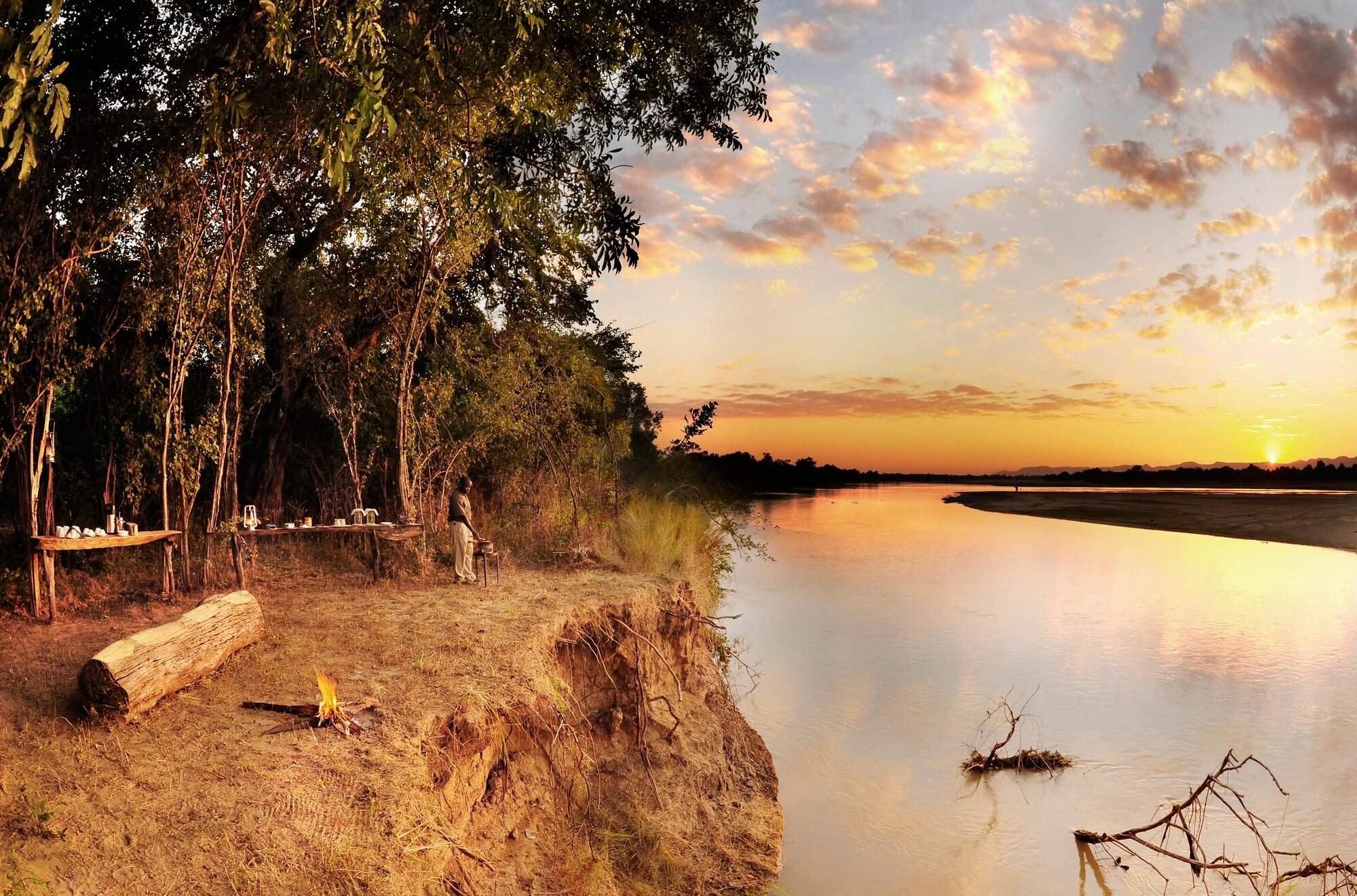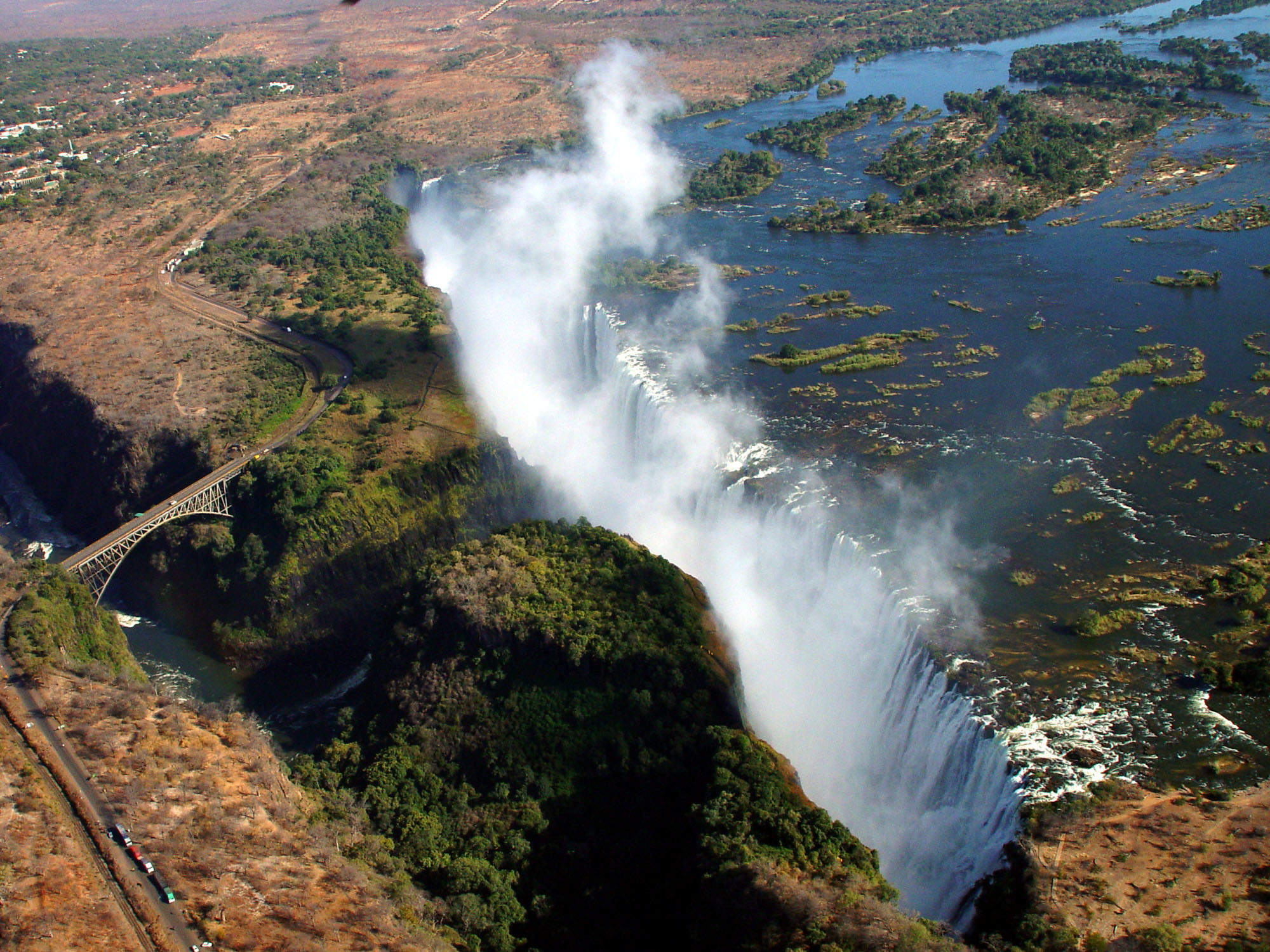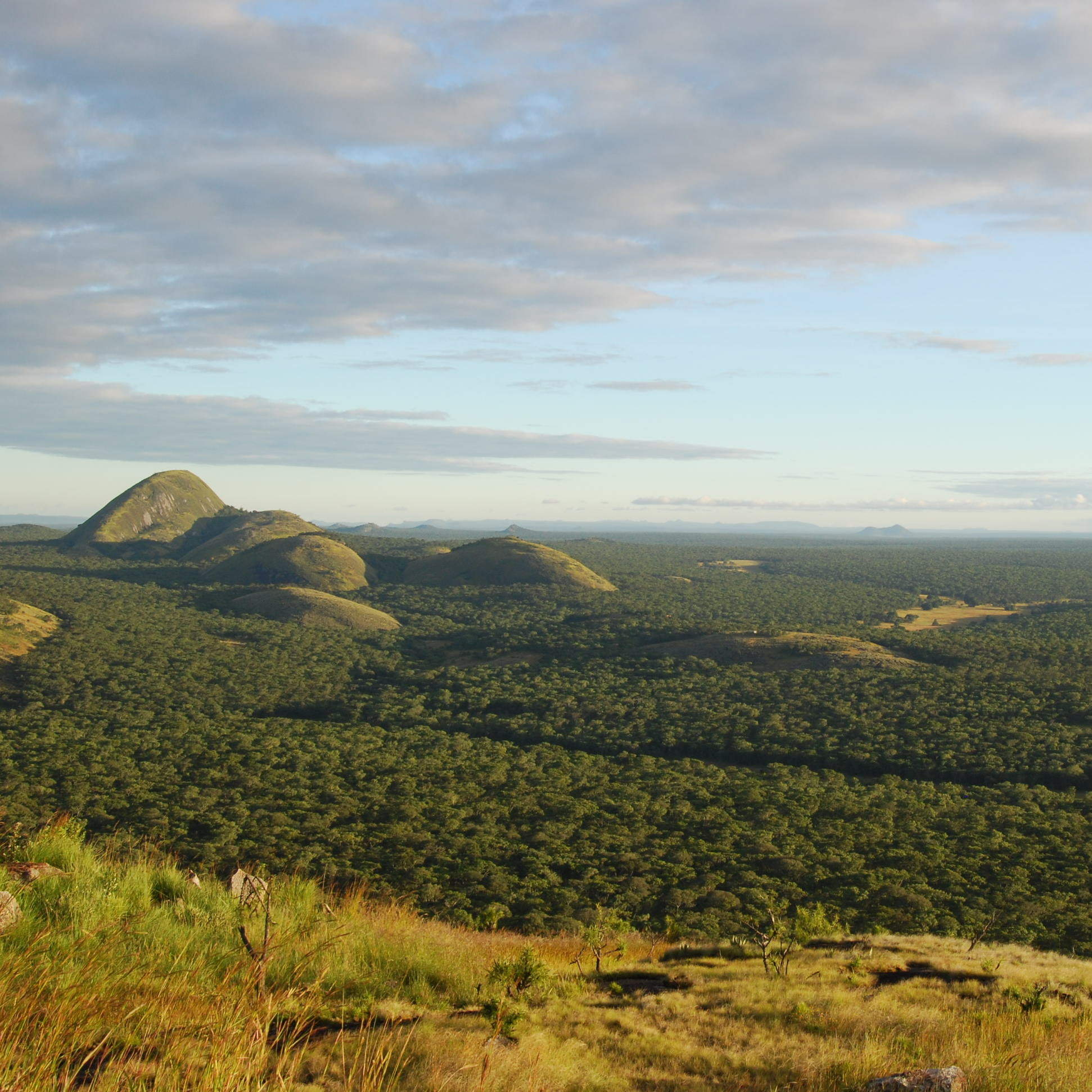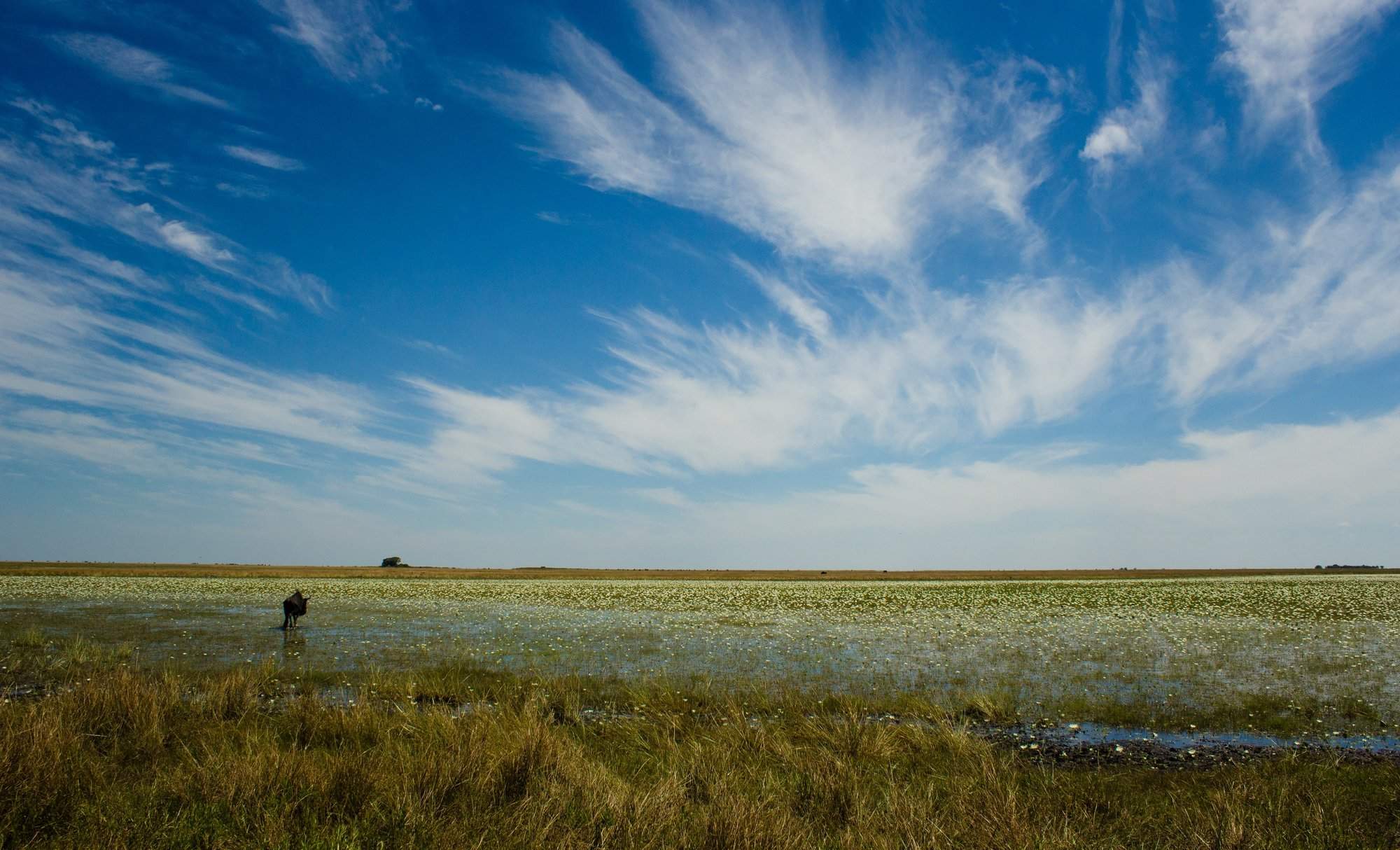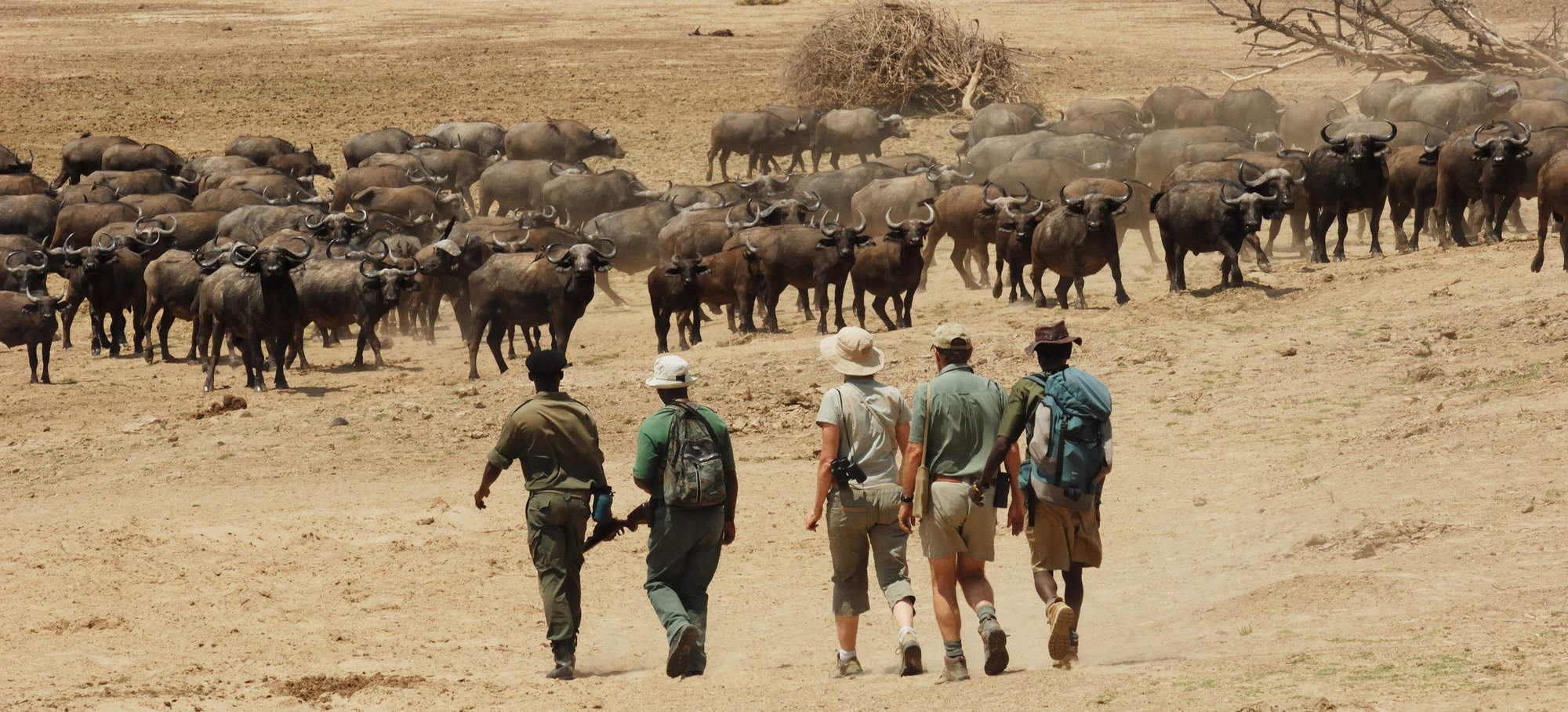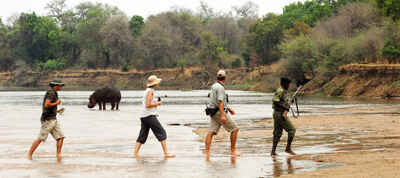
A great wilderness area for walking safaris
A lot can happen in front of your camp
Let sleeping lions lie ...
Barefoot on safari, what could be better ...
Mwaleshi, a bushcamp in North Luangwa
The camp overlooks the pristine Mwaleshi River.
North Luangwa National Park
North Luangwa National Park
Fresh tracks – buffalo, impala, lion – litter the rough paths, communicating the previous night’s activity to their human followers.
A bit of dung here; some disturbed grass there. For the experienced guides of the North Luangwa, this is the everyday language of the bush.
Animals of the North Park, as it is more generally known, inhabit a wilder world than that of the south. Roads are few, vehicles even fewer, and visitors barely register on the radar. For those that do venture this far, 4,636km2 of untamed land awaits exploration – largely on foot.
Descending from the hilly Muchinga Escarpment, and veined by tributaries of the Luangwa River that hug its eastern fringe, the park is inaccessible for more than half the year. Only in June, as the terrain starts to dry out, do the camps come into their own, their visitors arriving by light aircraft or – for those with an even greater taste for adventure – braving the bumpy six-hour trip overland.
Central to the park is the rhino sanctuary, whose denizens roam unseen within strictly guarded confines. Flowing around it is the beautiful Mwaleshi River, which dissects the park and is the focus of the few simple camps that exist up here.
These camps have an intimacy that is almost unequalled in the South Park. Yet beneath their simplicity lie comfortable beds, en-suite bathrooms, good food, and an efficiency of operation that includes exceptionally well-qualified guides – essential in this challenging environment.
While walking is indeed at the heart of their activities, drives are now also possible – giving access to areas of the park hitherto almost unvisited. And where the river is shallow, it’s possible to cross it on foot – or even to cool off with a drink. After a hot day in search of the park’s natural secrets, what more could you ask?

Safaris visiting North Luangwa
Just ideas, we'll always tailor-make a trip for you

Giraffe Safari
9 days • 3 locations
LUSAKA AIRPORT TO LUSAKA AIRPORT
A safari to the remotest parts of Zambia’s Luangwa Valley. Perfect for experienced safari goers and first-time Africa adventurers. Explore with expert guides whilst staying at small bushcamps.
US$8,700 - US$10,430 per person
Most recent reviews of our safaris to North Luangwa
Click below to browse all 75 reviews from North Luangwa National Park. All from our travellers; all are in full & unedited.
Arrived 21 Sep 2024, 11 nights
"Sep 2024 trip to South and North Luangwa"
Overall rating: Excellent
Arrived 17 Sep 2024, 12 nights
"My Sep 2024 trip"
Overall rating: Excellent
Arrived 11 Sep 2024, 38 nights
"Our Sep/Oct 2024 trip"
Overall rating: Excellent
Arrived 17 Aug 2024, 17 nights
"My Aug 2024 trip"
Overall rating: Excellent
Arrived 21 Jul 2024, 15 nights
"Return to Zambia 2024"
Overall rating: Excellent
Arrived 11 Jul 2024, 17 nights
"My Jul 2024 Luangwa trip"
Overall rating: Excellent
Arrived 30 Jun 2024, 14 nights
"My Jun 2024 trip"
Overall rating: Excellent
Arrived 13 Jun 2024, 15 nights
"My Jun 2024 trip"
Overall rating: Excellent
Arrived 11 Oct 2023, 14 nights
"My Oct 2023 trip"
Overall rating: Excellent
Arrived 10 Oct 2023, 14 nights
"My Oct 2023 trip"
Overall rating: Excellent
Where to stay in North Luangwa
Our suggestions for safari camps in North Luangwa National Park
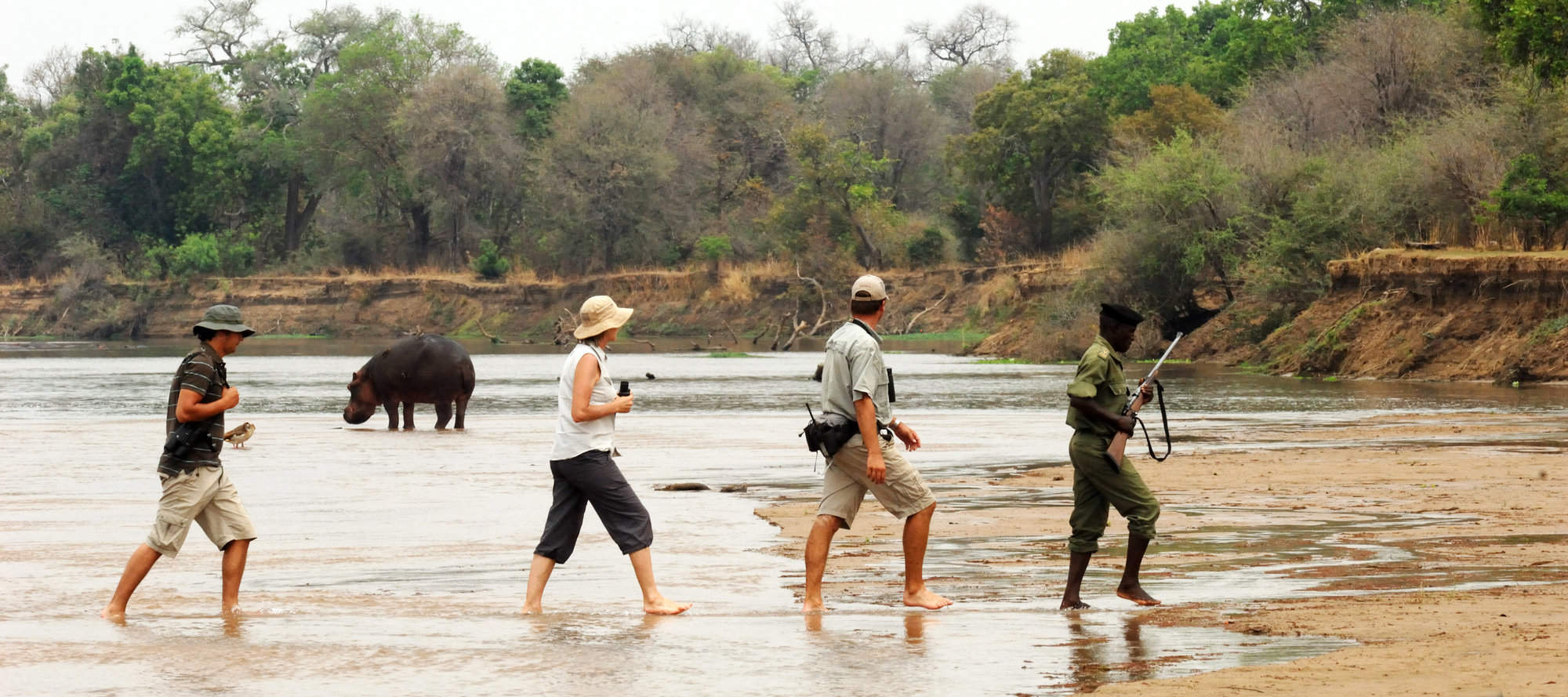
Mwaleshi Camp
Mwaleshi is a particularly remote and rustic bushcamp in North Luangwa National Park that concentrates purely on walking safaris. It's very small, but run by a top-quality operation – so come here for walking safaris run by super guides and an excellent wildlife experience.
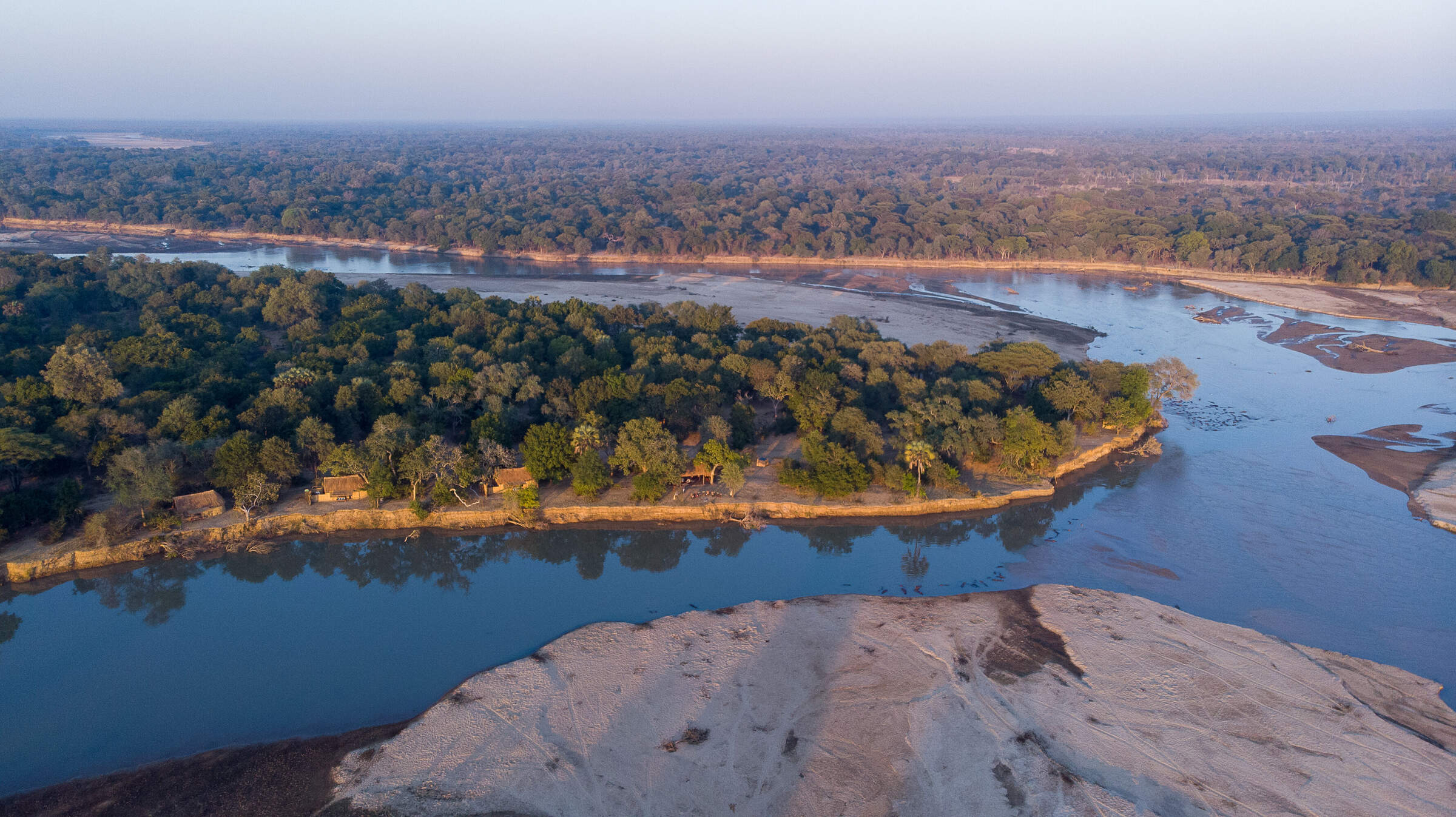
Takwela Camp
Remote, wild and very small, Takwela Camp offers excellent guiding on both walking safaris and game drives in Zambia's North Luangwa National Park.
Our travellers’ wildlife sightings in North Luangwa
This is their success for sightings in North Luangwa National Park. Click on a species for more detail. How we work this out.

100% success

100% success

87% success

79% success

74% success

65% success

65% success

32% success

12% success

3% success

3% success

0% success

0% success

0% success

0% success
When to go to North Luangwa National Park
North Luangwa National Park experiences distinct wet and dry seasons.
The wet season, from November to April, brings lush landscapes and abundant birdlife but challenging game viewing.
The dry season, May to October, offers excellent wildlife sightings as animals congregate around dwindling water sources. June to September is prime time, with pleasant temperatures and peak wildlife activity. However, October can be very hot.
For a more detailed guide to the pros and cons of visiting North Luangwa in each month, click on the months below.
Jan
Feb
Mar
Apr
May
Jun
Jul
Aug
Sep
Oct
Nov
Dec
North Luangwa National Park in January
In North Luangwa, January marks the peak of the wet season. Expect daily downpours, often lasting several hours, punctuated by brief sunny intervals. Temperatures soar above 30°C/86°F, accompanied by high humidity.
The landscape is a lush, green paradise, but this abundance of vegetation and water allows the larger game to spread out, making it much harder to spot. Birdlife thrives during this period, with numerous migratory species present – and many species sporting beautiful breeding plumage.
Many roads in the national park are impassable, limiting access. Safari camps in North Luangwa are closed and visitors are very scarce.
- Wet season peak, warm and moist climate
- Verdant scenery, ideal for nature photography
- Wildlife scattered, challenging to spot
- Vegetation high; no walking safaris
- Safari camps are closed
Our view
This is not a great time to visit
Weather in January
North Luangwa National Park in February
February in North Luangwa National Park is at the heart of the rains. Dramatic thunderstorms are a daily occurrence, often followed by clear skies.
The park remains verdant and waterlogged, making both getting around and game viewing challenging. However, patient observers with the logistics to get here may be rewarded with sightings of animals with their young.
The Mwaleshi River, swollen by the rains, can’t be easily crossed – adding to the very wild and remote feel of the park. Navigating by canoe would probably be easier than by safari vehicle!
The lush scenery and dramatic skies create excellent photographic opportunities for landscape enthusiasts who can get here.
- Rainy season continues, warm and humid weather
- Lush landscapes, but large animals hard to see
- Many birds resplendent in breeding plumage
- River levels high, altering park dynamics
- Scarce visitors, safari camps closed
Our view
This is not a great time to visit
Weather in February
North Luangwa National Park in March
March sees the gradual tapering of North Luangwa's rainy season. While heavy showers persist, they become less frequent. The park is at its most verdant, with water bodies at their fullest. Temperatures remain high, often exceeding 30°C/86°F, with considerable humidity.
Wildlife viewing remains challenging due to the thick vegetation, but predator activity increases as they take advantage of vulnerable young prey. Some palearctic migrant bird species start to migrate back north. As the skies begin to clear more frequently, the combination of dramatic clouds and lush landscapes provides stunning photographic possibilities.
- Final month of wet season, balmy and damp
- Abundant greenery with plenty of smaller animals
- Antelope species have young around
- Access to ( and safaris in) the park are challenging
- Safari camps remain closed
Our view
This is not a great time to visit
Weather in March
North Luangwa National Park in April
April marks a transition in North Luangwa as the heavy rains give way to occasional light showers. The landscape remains lush and green, but wildlife starts to become more visible as vegetation begins to thin. Safari camps remain closed. The levels of the Mwaleshi River begin to recede, exposing sandbanks that attract the odd basking crocodile.
This month offers a blend of green scenery and improving wildlife sightings. The air is clear, providing excellent visibility for photography. As visitor numbers are still low, those who visit can enjoy a sense of exclusivity in the park.
- Rainfall tapering off, warm and occasionally wet
- Verdant surroundings, wildlife viewing improving
- Rivers full, altering animal movement patterns
- More roads becoming accessible
- Very low numbers of safari visitors
Our view
This is not a great time to visit
Weather in April
North Luangwa National Park in May
May heralds the beginning of the dry season in North Luangwa. Rain becomes a rarity; most days are clear and sunny. Temperatures and humidity continue to reduce, with daytime highs around 25°C/77°F. The landscape begins its transformation from lush green to golden hues.
Wildlife viewing improves significantly as vegetation thins and the animals start appearing around permanent water sources. Most safari camps start to make ready or even reopen around the end of May, offering the first walking safaris of the season. The clear air and thinning vegetation provide excellent conditions for photography. May offers a good balance of comfortable weather, improved game viewing, and relatively low visitor numbers.
- Dry season onset, mostly clear and mild days
- Landscape still green, excellent for photographers
- Wildlife sightings becoming more frequent
- Vegetation thinning and drying
- Safari camps make ready, some reopen
Our view
A good time to visit, with pros & cons
Weather in May
North Luangwa National Park in June
June in North Luangwa National Park is characterised by cool, dry conditions. Daytime temperatures hover around 23°C/74°F, but nights can be chilly, dropping to around 10°C/50°F. The absence of rain and decreasing humidity make for comfortable safari conditions and lovely walking.
The thinning vegetation significantly improves visibility for game viewing. Camps in the park are open and operational during June. The Mwaleshi River becomes a focal point for wildlife safaris, offering excellent wildlife viewing. The clear skies and golden light make for stunning sunrise and sunset photography.
- Consistently sunny days, cooler nights
- Ideal conditions for guided walking safaris
- Animal viewing opportunities increasing
- Safari camps open and accessible
- Almost all roads now accessible
Our view
A very good time to visit
Weather in June
North Luangwa National Park in July
July brings winter to North Luangwa, with cold nights and mild days. Temperatures can drop to single digits at night but warm up to the low 20s°C/70s°F during the day.
The landscape is now predominantly golden, with much vegetation becoming drier. Wildlife is seen more often around the remaining water, particularly the Mwaleshi River, leading to excellent game viewing opportunities there.
Walking safaris in the national park are at their prime, with cool temperatures and good visibility. All camps are open and North Luangwa is as busy as it gets – although it remains a remote park with very few visitors. Early mornings can be particularly cold, so warm clothing is essential for game drives; it’s perfect weather for walking safaris.
- Pleasant days, chilly evenings
- Clear skies with very few clouds and no rain
- Vegetation thinning, enhancing visibility
- Wildlife sightings significantly improved
- Prime time for on-foot safari experiences
Our view
A very good time to visit
Weather in July
North Luangwa National Park in August
August in North Luangwa National Park is one of the best months for a walking safari as the days are clear and cloud-free, with wonderfully cool mornings as you start out. The dry conditions increasingly force wildlife to visit permanent water sources, making sightings more predictable. Daytime temperatures are pleasant, in the mid-20s°C/70s°F, even though nights and early mornings remain cold and fresh.
The vegetation has become more sparse, providing excellent visibility for wildlife spotting. There are a few less insects and smaller creatures around than earlier in the year. The dry conditions sometimes lead to a haze on the horizon, which can affect long-distance views and photography.
- Dry conditions, warm days and cool nights
- Optimal weather for walking safaris
- Excellent wildlife viewing near water sources
- Vegetation thinning out so easier to view wildlife
- Some haze may affect long-distance views
Our view
Fantastic: the very best time to visit
Weather in August
North Luangwa National Park in September
September is usually considered ‘the’ best month for visiting North Luangwa National park on safari. Daytime temperatures start to climb, reaching the low 30s°C/high 80s°F, while nights become more temperate. The landscape is dry, with excellent visibility for game viewing through drying vegetation.
Wildlife concentrates more around remaining water sources, leading to frequent and diverse sightings. It’s so shallow in parts that you can paddle across the Mwaleshi River – or cool your feet during a walk. Walking safaris are warming up, but still not too hot and offer thrilling close encounters with animals.
The tiny camps here are sometimes full, so planning ahead is essential. The conditions can create a heat of heat, dust and smoke which affects photography.
- Dry, warm days and mild nights
- Prime month for observing wildlife
- Great time for walking safaris
- Rivers and waterholes shrinking
- Landscape hazy from dust and bush fires
Our view
Fantastic: the very best time to visit
Weather in September
North Luangwa National Park in October
October marks the end of the dry season in the national park, bringing intense heat and anticipation of the rains. Daytime temperatures in North Luangwa climb and frequently exceed 35°C/95°F, with nights remaining very warm.
The landscape is parched, with most vegetation brown and lifeless. Wildlife viewing reaches its peak as animals desperately seek out the few remaining water sources. Predator-prey interactions are common, offering exciting but sometimes intense viewing experiences. Walking safaris are challenging due to the heat. Safari camps start to close towards the end of the month. The dry conditions can create a haze of heat and dust, affecting visibility and photography.
- Optimal chances to see the wildlife
- Very warm temperatures, day and night
- Environment feels harsh and arid with the heat
- Water sources scarce, concentrating animals
- Hazy atmosphere, challenging for photographers
Our view
A very good time to visit
Weather in October
North Luangwa National Park in November
November typically sees the return of rains to North Luangwa, though the timing is always unpredictable. Early in November, conditions remain hot and dry, but when rains arrive, the landscape begins a rapid transformation.
Temperatures remain high, often above 30°C/86°F, with increasing humidity. Initial rains bring rapid greening of the landscape and dispersal of wildlife. Game viewing becomes more challenging as animals are no longer confined to limited water sources.
Safari camps are closing as access becomes difficult: bush roads become impassable when heavy rains start. The rains clears the air of dust and haze, creating vibrant, clear air that is excellent for photography.
- Wet season beginning, hot and muggy
- Increasing likelihood of rainfall
- Wildlife dispersing as vegetation busts into life
- Insects and smaller creatures emerge
- Birds starting to don breeding plumage
Our view
A good time to visit, with pros & cons
Weather in November
North Luangwa National Park in December
December is firmly in the grip of the wet season in North Luangwa National Park. Regular thunderstorms occur, often in the afternoons, followed by periods of sunshine. The landscape becomes increasingly verdant. Temperatures remain high, often exceeding 30°C/86°F, with high humidity.
Wildlife viewing is challenging as animals disperse across the now water-rich environment. However, this is an excellent time for birdwatching, with many migratory species present. Safari camps in the park are closed and very few visitors are here to witness the park's dramatic seasonal transformation.
The combination of stormy skies and green landscapes offers unique photographic opportunities.
- Rainy season underway, warm and wet days
- Wildlife harder to spot in thick vegetation
- Lush scenery, improved photographic conditions
- Safari camps now closed for the season
- Very few visitors as most roads inaccessible
Our view
This is not a great time to visit
Weather in December
North Luangwa National Park: In detail
A guide to North Luangwa National Park
North Luangwa National Park, usually known just as ‘the North Park’, covers 4,636km² of the Luangwa Valley.
The North Park is largely untouched, with few roads and restricted public access, offering a wilder experience of the Luangwa Valley than the much larger South Park.
To get the most out of North Luangwa National Park, our travellers generally visit one of the few camps for walking safaris within the park. Typically a three- to five-night stay at one of the walking camps is perfect, and these camps only operate during the dry season, from June to October.
The North Park can be accessed by air or road. From Mfuwe or Lukuzi in the South Park, a short flight to the North Luangwa airstrip is the easiest and most comfortable way to enter the park. Alternatively, and for more adventurous travellers, North Luangwa National Park can be reached over land, requiring a six-hour drive across rough terrain.
Wildlife of North Luangwa
Animals of North Luangwa National Park
The game in the North Park is similar to the South Park, although there are some notable differences.
The escarpment brings some more unusual mammals to the North Park, including occasional sightings of sable antelope, bushpig and blue monkeys.
In the North Park you’re more likely to see Cookson’s wildebeest, one of the valley’s endemic subspecies. However, you won’t find any giraffes here, they are rarely seen north of the Mupamadzi River. Eland, the largest antelope, are more common in North Luangwa, and Lichtenstein’s hartebeest are also seen more often than in the South Park.
Following the high levels of poaching in the 1980s elephant are scarce and skittish in the North Park. This is changing and the population is growing, but it’ll take a long time before they can match the elephant presence in the South Park.
Lion and buffalo are numerous in the North Park, with buffalo herds even larger than those in South Luangwa, and some very strong prides of lion.
North Luangwa National Park is host to an exciting black rhino re-introduction program. In 2003, five black rhino were introduced into a large fenced-off intensive protection zone, at the heart of the park, with a further ten added in 2006. Despite the death of two of the animals, two baby rhinos were born in the sanctuary, a measure of the project’s success, and a big step towards the aim to establish 20 animals within the now extended sanctuary area.
Birds of North Luangwa National Park
North Luangwa is home to all of the birds species found in South Luangwa. Frequently sighted birds are the carmine bee-eater, giant eagle owl, Pel’s fishing owl, broad billed roller, Lillian’s lovebird, purple crested lorries and crowned cranes.
Furthermore, the North Park is home to a couple of East African bird species that don’t usually occur further south – like the chestnut-mantled sparrow weaver, the white-winged starling and especially the yellow-throated longclaw.
Vegetation of North Luangwa National Park
The 12km long road from Mano down the escarpment, for example, gives one an excellent opportunity to see the difference to the South Luangwa. This road leads you from the two-storey woodlands of the upper and plateau escarpment, with a lightly closed canopy of semi-evergreen trees 15–20m high, down through the Miombo woodlands on the hills to vegetation more typical of the valley as most people know it.
The area south of the Mwaleshi River boasts a huge variety of vegetation, ranging from red mahogany, vegetable ivory palms, leadwood, acacia thicket and open grasslands, morpane woodland to riverine forest and sausage trees.
Map of North Luangwa National Park
Choices for where to stay in North Luangwa National Park
North Luangwa National Park: Safaris
North and South Luangwa share the same ecosystem and largely the same species – but they differ a little for visitors. Whilst camps in South Luangwa can offer both game drives and walking safaris, safari holidays in North Luangwa focus purely on walking.
North Luangwa tends to be more of a challenge to get to, and more expensive – so it is not usually ideal for those on their first safari holiday. However, more experienced travellers will enjoy the remote and untouched nature of North Luangwa – far beyond the reach of the modern world.

Giraffe Safari
9 days • 3 locations
LUSAKA AIRPORT TO LUSAKA AIRPORT
A safari to the remotest parts of Zambia’s Luangwa Valley. Perfect for experienced safari goers and first-time Africa adventurers. Explore with expert guides whilst staying at small bushcamps.
US$8,700 - US$10,430 per person
2 safari camps in North Luangwa National Park
Being very remote and only accessible for part of the year, the bushcamp stands on the banks of the Mwaleshi, one of the few sources of water for the game, which consequently gravitates to it. The camp is delightfully simple yet well equipped.

Mwaleshi Camp
Mwaleshi is a particularly remote and rustic bushcamp in North Luangwa National Park that concentrates purely on walking safaris. It's very small, but run by a top-quality operation – so come here for walking safaris run by super guides and an excellent wildlife experience.

Takwela Camp
Remote, wild and very small, Takwela Camp offers excellent guiding on both walking safaris and game drives in Zambia's North Luangwa National Park.

Looking for inspiration on where to travel next?
Visit our trip chooser to explore your options and find inspiration for your perfect African adventure
Inspire me